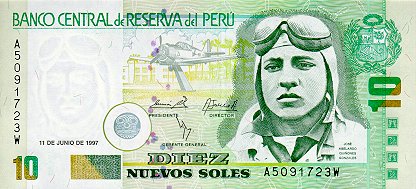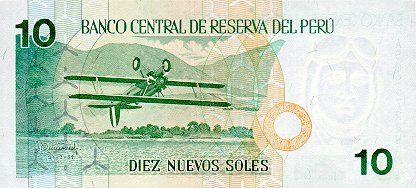
All the time that I was in Lima, my friend Jorge kept explaining that Peru's history is kind of unusual. Others I met during the trip have supported this. Some of it is pretty humorous and some of it best forgotten, but it becomes apparent that though history follows time, it's not necessarily linear.
A good illustration is the terracing that you find all over Peru. Before the Spaniards, there was an extensive system of irrigation, and it supported a large population. In time, earthquakes changed the angle of things, and progress literally started to flow backwards.
Peru's independence, I was told, wasn't mainstream, either. Most colonial countries fight for their independence. Peru was "liberated" (invaded) by the Argentines, who didn't want the Spaniards to have a base too near to them. When San Martín marched into Lima with his army, people threw tomatoes at them.
One of the more amazing pieces of history was the War of the Pacific (1879-83), which, to the best of my understanding, was fought over guano deposits. Peru had signed a mutual defense pact with Bolivia. Bolivia was foolish enough to start up with Chile, and Peru had to honor the treaty, just after they had cut the military. Chile took away the entire Pacific coast of Bolivia, leaving Bolivia landlocked to this day. The Bolivians sued for peace. The Peruvians also sued for peace, but Chile was having such a good time that they didn't want to stop. They destroyed the Peruvian navy, occupied Lima, and bit off a good-sized chunk of Peru, returning a piece of it (Tacna) as recently as 1929.
When you arrive in Lima, it's through Jorge Chávez International Airport. Jorge Chávez was a celebrated Peruvian aviator. Actually, Georges Chavée was a rich French kid with a plane, who came to Peru and founded a vanity air force. I tried to verify some facts about Jorge Chávez, but haven't found a single word written about him. Having identified this gaping, yawning need, perhaps someone will find the motivation to write a thin book on Peruvian aeronautical history. Until then, Mr. Chávez will have to be happier being rich than being famous. Another aviation hero, Alejandro Quiñones, was shot down over Ecuador. He did better by getting his likeness on the 10 sole note. The reverse side has his plane upside down.
Leadership has also been a bit of an issue, with the military "helping out" from time to time. Prime Minister Manuel Ulloa, who was a womanizer, and rumored to use cocaine, had to be dragged out of the Palace of Torre Tagle during a coup when he refused to leave. Later on, he married a princess, became a prince, and later still, died. President Belaúnde Terry, who was older, good-natured and ineffectual, was woken out of a sound sleep so he could be deposed and exiled. He arrived at Miami airport in his bathrobe. Belaúnde was reelected in 1980.
At the time I was in Peru, they were looking for Alan García, who started as a dark horse reformer, but ended as one of the richest men in the world. To this end, he invested the entire Peruvian social welfare fund in his personal, Swiss bank account. He, too, ran for reelection in 2001. Even Fujimori, the man who broke the Shining Path, ended up hiding out in Japan. Fujimori is a splashy character, and his colorful divorce made page one entertainment for months. There's no doubt that he'll be back as well.
There was one instance, though, where Peru gave as good as it got. The Peruvian phone system was a shambles, and it was decided to sell it off to the highest bidder. When the sealed bids were opened, it turned out that the Telefónica de España was the winner, and had bid three times the price of the nearest competitor. The reward? The Peruvian telephones. Spain might have brought pillage, plunder, smallpox and the Inquisition, but Atahualpa finally called in a bit of revenge.
Alejandro Quiñones, front and back, up and down.


Stolen from: Ron Wise's World Paper Money Homepage